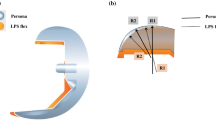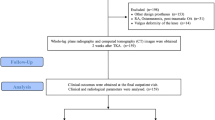Abstract
Purpose
External rotation of femoral component in total knee arthroplasty (TKA) with reference to the posterior condyles is recommended in mechanical alignment (MA) to ensure optimum patella tracking. In kinematic knee alignment (KA) technique, femoral component is more internally rotated as the femoral resection is based on flexion–extension axis. This study aims to investigate the clinical and radiological outcomes of the patellofemoral joint in patients who underwent TKA using KA versus mechanical alignment.
Methods
A review of prospectively collected registry data of 378 consecutive cruciate retaining primary TKAs (P.F.C.® Total Knee System, DePuy Synthes, Massachusetts, United States) was performed. Propensity scoring was performed matching patients who received KA TKA (n = 93) to MA TKA (n = 93). Oxford Knee Score (OKS), Knee Society Score (KSS), Short-Form 36 (SF-36), range of motion as well as radiographs assessing patella tilt were compared at 6 months and 2 years after surgery. All patients received the same implant and had their patella resurfaced.
Results
OKS, KSS, physical component of SF-36 and satisfaction rates were comparable at both 6 months and 2 years after surgery. There was moderate association between preoperative and postoperative patella tilt in KA TKA (Cramer’s V = 0.260, p < 0.05). Postoperatively, KA group had a greater number of patients with lateral patella tilt compared to the mechanical group (12 [12.9%] vs 1 [1.1%], p < 0.001). Patella tilts, however, resolved two years after surgery.
Conclusion
The relative internal rotation of the femoral component in KA TKA results in greater incidence of lateral patella tilt postoperatively. Nevertheless, patella tilt resolution was noted at 2 years.
Level of evidence
Level III Evidence—Retrospective Cohort Study.

Similar content being viewed by others
References
Abdel MP, Ollivier M, Parratte S, Trousdale RT, Berry DJ, Pagnano MW (2018) Effect of postoperative mechanical axis alignment on survival and functional outcomes of modern total knee arthroplasties with cement: a concise follow-up at 20 years. J Bone Jt Surg Am 100:472–478
Baldini A, Anderson JA, Cerulli-Mariani P, Kalyvas J, Pavlov H, Sculco TP (2007) Patellofemoral evaluation after total knee arthroplasty. Validation of a new weight-bearing axial radiographic view. J Bone Jt Surg Am 89:1810–1817
Beard DJ, Pandit H, Ostlere S, Jenkins C, Dodd CAF, Murray DW (2007) Pre-operative clinical and radiological assessment of the patellofemoral joint in unicompartmental knee replacement and its influence on outcome. J Bone Jt Surg Br 89:1602–1607
Bellemans J, Colyn W, Vandenneucker H, Victor J (2012) The Chitranjan Ranawat award: is neutral mechanical alignment normal for all patients? The concept of constitutional varus. Clin Orthop Relat Res 470:45–53
Bilgin E, Bombacı H, Turgut A, Kalenderer Ö, Kılınç BE, Adıyeke L, Görgeç M (2019) How are clinical outcomes related to the deviation severity of the tibiofemoral mechanical axis on coronal plane following knee arthroplasty? J Clin Orthop Trauma 10:91–95
Bindelglass DF, Cohen JL, Dorr LD (1993) Patellar tilt and subluxation in total knee arthroplasty. Relationship to pain, fixation, and design. Clin Orthop Relat Res 286:103–109
Brar AS, Howell SM, Hull ML, Mahfouz MR (2016) Does kinematic alignment and flexion of a femoral component designed for mechanical alignment reduce the proximal and lateral reach of the trochlea? J Arthroplasty 31:1808–1813
Cohen J (1960) A coefficient of agreement for nominal scales. Educ Psychol Measur 20:37–46
Daltroy LH, Cats-Baril WL, Katz JN, Fossel AH, Liang MH (1996) The North American spine society lumbar spine outcome assessment Instrument: reliability and validity tests. Spine 21:741–749
Dawson J, Fitzpatrick R, Murray D, Carr A (1998) Questionnaire on the perceptions of patients about total knee replacement. J Bone Jt Surg Br 80:63–69
Delport H, Labey L, Innocenti B, De Corte R, Vander Sloten J, Bellemans J (2015) Restoration of constitutional alignment in TKA leads to more physiological strains in the collateral ligaments. Knee Surg Sports Traumatol Arthrosc 23:2159–2169
Gharaibeh MA, Monk E, Chen DB, MacDessi SJ (2018) Evaluation of the patellofemoral joint in total knee arthroplasty: validation of the weight bearing merchant radiographic view. Knee 25:1262–1271
Gomes LS, Bechtold JE, Gustilo RB (1988) Patellar prosthesis positioning in total knee arthroplasty. A roentgenographic study. Clin Orthop Relat Res 236:72–81
Hernigou P, Deschamps G (2002) Patellar impingement following unicompartmental arthroplasty. J Bone Jt Surg Am 84:1132–1137
Hess S, Moser LB, Amsler F, Behrend H, Hirschmann MT (2019) Highly variable coronal tibial and femoral alignment in osteoarthritic knees: a systematic review. Knee Surg Sports Traumatol Arthrosc 27:1368–1377
Hirschmann MT, Moser LB, Amsler F, Behrend H, Leclerq V, Hess S (2019) Functional knee phenotypes: a novel classification for phenotyping the coronal lower limb alignment based on the native alignment in young non-osteoarthritic patients. Knee Surg Sports Traumatol Arthrosc 27:1394–1402
Howell SM (2019) Calipered kinematically aligned total knee arthroplasty: an accurate technique that improves patient outcomes and implant survival. Orthopedics 42:126–135
Howell SM, Kuznik K, Hull ML, Siston RA (2010) Longitudinal shapes of the tibia and femur are unrelated and variable. Clin Orthop Relat Res 468:1142–1148
Howell S, Howell S, Kuznik K, Cohen J, Hull M (2013) Does a kinematically aligned total knee arthroplasty restore function without failure regardless of alignment category? Clin Orthop Relat Res 471:1000–1007
Keshmiri A, Maderbacher G, Baier C, Benditz A, Grifka J, Greimel F (2019) Kinematic alignment in total knee arthroplasty leads to a better restoration of patellar kinematics compared to mechanic alignment. Knee Surg Sports Traumatol Arthrosc 27:1529–1534
Kujala UM, Jaakkola LH, Koskinen SK, Taimela S, Hurme M, Nelimarkka O (1993) Scoring of patellofemoral disorders. Arthroscopy 9:159–163
Landis JR, Koch GG (1977) The measurement of observer agreement for categorical data. Biometrics 33:159–174
Laurin CA, Dussault R, Levesque HP (1979) The tangential x-ray investigation of the patellofemoral joint: x-ray technique, diagnostic criteria and their interpretation. Clin Orthop Relat Res 144:16–26
Lee S-S, Lee H, Lee D-H, Moon Y-W (2018) Slight under-correction following total knee arthroplasty for a valgus knee results in similar clinical outcomes. Arch Orthop Trauma Surg 138:1011–1019
Lozano R, Campanelli V, Howell S, Hull M (2019) Kinematic alignment more closely restores the groove location and the sulcus angle of the native trochlea than mechanical alignment: implications for prosthetic design. Knee Surg Sports Traumatol Arthrosc 27:1504–1513
Magnussen RA, Weppe F, Demey G, Servien E, Lustig S (2011) Residual varus alignment does not compromise results of TKAs in patients with preoperative varus. Clin Orthop Relat Res 469:3443–3450
Matsumoto T, Takayama K, Ishida K, Hayashi S, Hashimoto S, Kuroda R (2017) Radiological and clinical comparison of kinematically versus mechanically aligned total knee arthroplasty. Bone Jt J 99-B:640–646
Nedopil AJ, Howell SM, Hull ML (2017) What clinical characteristics and radiographic parameters are associated with patellofemoral instability after kinematically aligned total knee arthroplasty? Int Orthop 41:283–291
Ng CK, Chen JY, Yeh JZY, Ho JPY, Merican AM, Yeo SJ (2018) Distal femoral rotation correlates with proximal tibial joint line obliquity: a consideration for kinematic total knee arthroplasty. J Arthroplasty 33:1936–1944
Parratte S, Pagnano MW, Trousdale RT, Berry DJ (2010) Effect of postoperative mechanical axis alignment on the fifteen-year survival of modern, cemented total knee replacements. J Bone Joint Surg Am 92:2143–2149
Peat G, Duncan RC, Wood LR, Thomas E, Muller S (2012) Clinical features of symptomatic patellofemoral joint osteoarthritis. Arthritis Res Ther 14:R63
Ritter MA, Faris PM, Keating EM, Meding JB (1994) Postoperative alignment of total knee replacement. Its effect on survival. Clin Orthop Relat Res 299:153–156
Ritter MA, Davis KE, Meding JB, Pierson JL, Berend ME, Malinzak RA (2011) The effect of alignment and BMI on failure of total knee replacement. J Bone Jt Surg Am 93:1588–1596
Rivière C, Iranpour F, Harris S, Auvinet E, Aframian A, Parratte S, Cobb J (2018) Differences in trochlear parameters between native and prosthetic kinematically or mechanically aligned knees. Orthop Traumatol Surg Res 104:165–170
Slevin O, Hirschmann A, Schiapparelli FF, Amsler F, Huegli RW, Hirschmann MT (2018) Neutral alignment leads to higher knee society scores after total knee arthroplasty in preoperatively non-varus patients: a prospective clinical study using 3D-CT. Knee Surg Sports Traumatol Arthrosc 26:1602–1609
Waterson HB, Clement ND, Eyres KS, Mandalia VI, Toms AD (2016) The early outcome of kinematic versus mechanical alignment in total knee arthroplasty. Bone Jt J 98-B:1360–1368
Young SW, Walker ML, Bayan A, Briant-Evans T, Pavlou P, Farrington B (2017) The Chitranjan S. Ranawat Award : no difference in 2-year functional outcomes using kinematic versus mechanical alignment in TKA: a randomized controlled clinical trial. Clin Orthop Relat Res 475:9–20
Funding
There was no financial conflict of interest with regards to this study.
Author information
Authors and Affiliations
Corresponding author
Ethics declarations
Conflict of interest
Authors Don Thong Siang Koh, Yew Lok Woo, Andy Khye Soon Yew and Seng-Jin Yeo declare that they have no conflict of interest.
Ethical approval
This study was approved by the institution’s ethics committee (SingHealth CIRB: 2015/2632) and carried out in accordance with the ethical standards laid down in the 1964 Declaration of Helsinki.
Additional information
Publisher's Note
Springer Nature remains neutral with regard to jurisdictional claims in published maps and institutional affiliations.
Rights and permissions
About this article
Cite this article
Koh, D.T.S., Woo, Y.L., Yew, A.K.S. et al. Kinematic aligned femoral rotation leads to greater patella tilt but similar clinical outcomes when compared to traditional femoral component rotation in total knee arthroplasty. A propensity score matched study. Knee Surg Sports Traumatol Arthrosc 29, 1059–1066 (2021). https://doi.org/10.1007/s00167-020-06081-7
Received:
Accepted:
Published:
Issue Date:
DOI: https://doi.org/10.1007/s00167-020-06081-7




